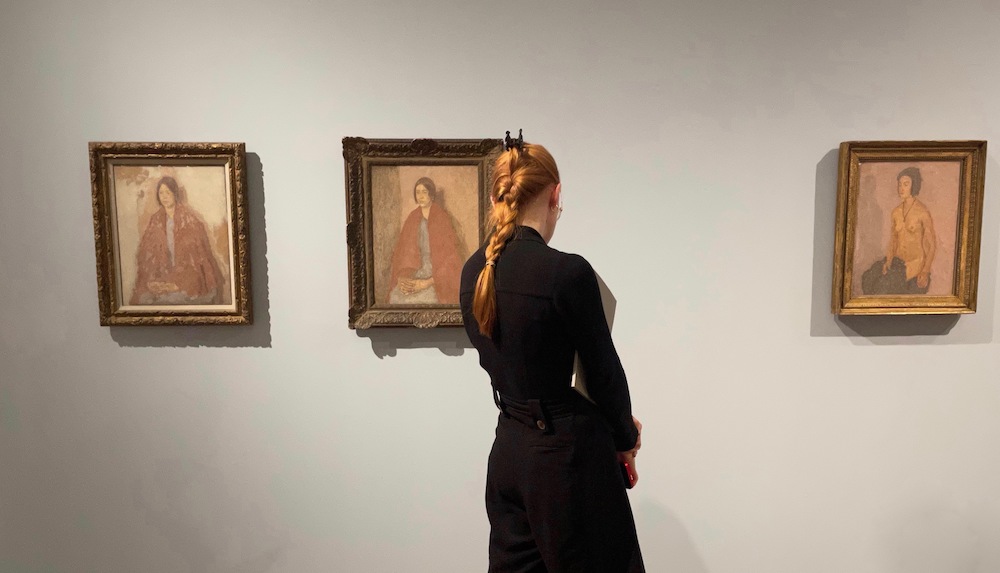Gwen John: Art and Life in London and Paris has just opened at Pallant House Gallery, Chichester. This substantial yet intimate exhibition chronologically traces John’s 40-year career in the two cities where she chose to live and work. She lived and worked during one of the most productive eras in the story of European art in two of the most exciting cities.
Gwen John’s paintings of domestic interiors were part of a broader interest in the subject.
Welsh-born artist Gwen John (1876-1939) is known for her paintings and drawings of women, domestic interiors, and, of course, her pictures of cats. She is usually considered alongside her brother, fellow artist Augustus John. Also, any mention of her is often accompanied by a reference to her ten-year relationship with the sculptor Auguste Rodin in the typical manner of describing women artists in terms of their relationships with the men surrounding them. In addition, she has also previously been considered to have been a recluse: the romantic notion of the lone artist painting alone in her Parisian attic. Her paintings of single figures in muted colours in empty rooms supported this theory.
In this exhibition, curator Alicia Foster shows that far from being reclusive, Gwen John was part of an active artistic community first in London, where she studied at the Slade and then in Paris, where she subsequently chose to live. Although John was fiercely independent and enjoyed her solitude, she was very much part of the cultural milieu of Paris. Through modelling to support her independent existence, she met the sculptor Auguste Rodin who introduced her to the poet Rainer Maria Rilke. She visited exhibitions, exhibited at the Paris Salons and maintained friendships with a circle of now lesser-known women artists such as Mary Constance Lloyd and Ursula Tyrwhitt, whom she met during her early years in England. Foster maintains that far from being about isolation, her work is about connectivity.

This brings us back to the paintings of Gwen John. Her choice of subjects: single female figures and sparse domestic interiors, are characterised by soft, muted colours and spare, minimalist compositions, which convey a sense of quiet contemplation and introspection but are so much more. They bare more than a homage to James Abbott McNeill Whistler. She studied in Paris at Whistler’s Académie Carmen. Paintings of domestic interiors were part of a broader interest in the subject. In France, Edouard Vuillard was tackling the same genre. However, whereas John’s paintings are of sparse rooms made up of a single chair and window, Vuillard’s paintings are populated by friends and family members and crowded with competing patterns of wallpapers, textiles and latticed windows, emphasising the flatness of the picture plane. In England, Walter Sickert’s quiet domestic scenes are juxtaposed with drama. Spencer Gore, another Camden Town Group artist, was producing similar interior scenes. In Denmark, Vilhelm Hammershoi was painting sparse interiors with single figures in rooms lit by direct light. Johnn’s paintings have a lightness of touch with softer edges than her Danish counterpart. The exhibition includes examples of Vuillard’s, Sickert’s, Gore’s and Hammershoi’s works as comparisons.
Other comparative works on display are by John’s fellow Slade students, such as Ambrose McEvoy, Ursula Tyrwhitt, Ida Nettleship, Gwen Salmond, and her brother Augustus John. Plus a drawing by Pierre Puvis de Chavannes, whom John admired; a drawing by Paula Modersohn-Becker, who was in Paris at the same time, although it is not known if the two ever met; a painting by Mary Constance Lloyd, sketches by Auguste Rodin and a painting of the Head of a Boy by Paul Cézanne.
However, even among these choice works, Gwen John’s works stand out. The set of three paintings entitled The Convalescent covers a fifteen-year period. They all depict a young girl seated in an openwork chair reading a book next to a table with a teapot, cup and saucer. Each one slightly different in texture and details but united in tone and sentiment. Her single figures all look to one side rather than head-on. They are centrally placed, often seated at a table with hands clasped together.
In 1913 Gwen John converted to Catholicism. At this time, she created a series of paintings of the founder of an order of nuns who were her neighbours in Meudon, France, as well as young women in the religious order. She was influenced by Maurice Denis and his call for religious art that embraced modernism. These portraits are displayed at Pallant House in church-like arches, the stiffness of their robes juxtaposed with the contemporary faces.
The works are all small-scale and, in places, are salon-hung. So every time you circumvent the intimate exhibition space, you see something new or something different in each work. In addition, display cases contain sketchbooks, letters and other archival material, building up an image of Gwen John’s life and work. Well worth a trip to Chichester.
Words and photos by Sara Faith ©Artlyst 2023
Gwen John: Art and Life in London and Paris, Pallant House Gallery, Chichester, Sussex 13 May-8 October 2023
Visit Here
Gwen John: Art and Life in London and Paris by Alicia Foster, published by Thames & Hudson ISBN:9780500025574
Buy Here
Two Poems From ‘God’s Little Artist’ on the Life of Gwen John by Sue Hubbard
to be published by Seren Poets in September 2023


